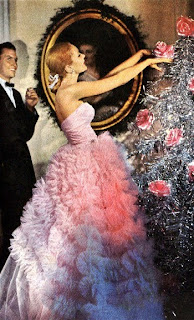There are two main types of ruffles: straight ruffles and circular ruffles. Today I will teach you how to make straight ruffles. Its quite simple, but I will also show you variations, and examples of how gathered ruffles can be used to create different effects.
Starting off with the basics:
1)tear or cut strips of fabric in the desired width. I am using 3 " wide strips in this example. For length, you will want the strip to be 1.5-2 times longer than the desired finished length of the ruffle. (ex. if you need a ruffle that is 12" long, you will need to start with a strip that is 18-24 inches long). the more length you add, the more tightly gathered ruffle you can create.
Machine baste two rows about 1/4 inch apart. (basting would be the greatest stitch length your machine can do).
Pull the threads on the underside of strip in order to gather up the fabric.
Continue to pull and spread out the gathers to create an even look and obtain the desired length.
The above method was used to make the ruffle at the bottom of this dress:
a couple of tips:
1) if you find that the bottom strings do not want to pull/ gather easily, try adjusting your tension so that the bottom thread is easier to pull.
2) cutting the strips with the grainline gives you a different type of ruffle than cutting the strips against the grainline. As a general rule of thumb, cutting your strips with the grainline will give you a more organized and uniform ruffle, where as cutting the strips against the grain will give you a bouncier looking ruffle.... correct me if I mixed that up , Barb :) Different fabrics will give you different results so experiment.
Example of ruffle cut against grain:
3)If you are working with a heavier fabric, you may find that your threads break when you are trying to pull them to gather. Try 3 rows of stitches. If that doesnt work, try a heavier weight thread. And if that doesnt work, you can zig zag stitch over a very narrow piece of cording or thin ribbon, and pull on the cording to gather up the fabric.
Straight ruffle variations include:
sewing the gathering stitch in the middle:
Example of how I use this variation:
Using a folded strip in order to get a softer edge:
This type of ruffle works well when you are making a garment in which you will see both sides of the ruffle. Example:
Pleating the fabric:
Pleated ruffle used on a capelet:
And finally, if you take the straight ruffle and wrap it around itself, you can create flowers!
















